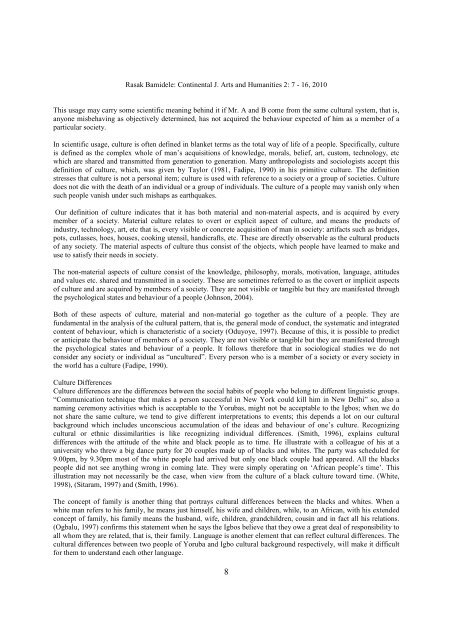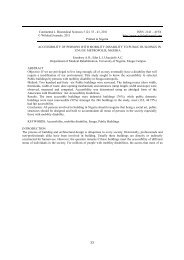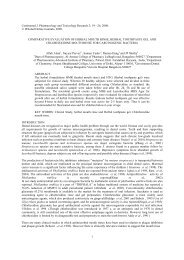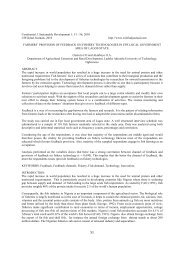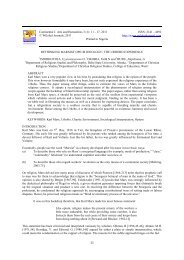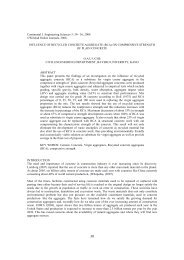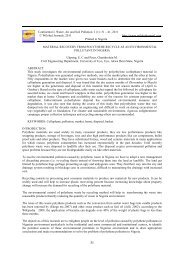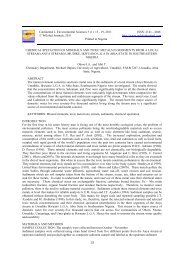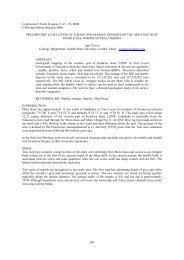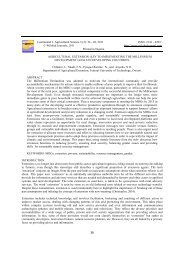Vol 2 - Arts and Humanities - Wilolud Journals
Vol 2 - Arts and Humanities - Wilolud Journals
Vol 2 - Arts and Humanities - Wilolud Journals
Create successful ePaper yourself
Turn your PDF publications into a flip-book with our unique Google optimized e-Paper software.
Rasak Bamidele: Continental J. <strong>Arts</strong> <strong>and</strong> <strong>Humanities</strong> 2: 7 - 16, 2010This usage may carry some scientific meaning behind it if Mr. A <strong>and</strong> B come from the same cultural system, that is,anyone misbehaving as objectively determined, has not acquired the behaviour expected of him as a member of aparticular society.In scientific usage, culture is often defined in blanket terms as the total way of life of a people. Specifically, cultureis defined as the complex whole of man’s acquisitions of knowledge, morals, belief, art, custom, technology, etcwhich are shared <strong>and</strong> transmitted from generation to generation. Many anthropologists <strong>and</strong> sociologists accept thisdefinition of culture, which, was given by Taylor (1981, Fadipe, 1990) in his primitive culture. The definitionstresses that culture is not a personal item; culture is used with reference to a society or a group of societies. Culturedoes not die with the death of an individual or a group of individuals. The culture of a people may vanish only whensuch people vanish under such mishaps as earthquakes.Our definition of culture indicates that it has both material <strong>and</strong> non-material aspects, <strong>and</strong> is acquired by everymember of a society. Material culture relates to overt or explicit aspect of culture, <strong>and</strong> means the products ofindustry, technology, art, etc that is, every visible or concrete acquisition of man in society: artifacts such as bridges,pots, cutlasses, hoes, houses, cooking utensil, h<strong>and</strong>icrafts, etc. These are directly observable as the cultural productsof any society. The material aspects of culture thus consist of the objects, which people have learned to make <strong>and</strong>use to satisfy their needs in society.The non-material aspects of culture consist of the knowledge, philosophy, morals, motivation, language, attitudes<strong>and</strong> values etc. shared <strong>and</strong> transmitted in a society. These are sometimes referred to as the covert or implicit aspectsof culture <strong>and</strong> are acquired by members of a society. They are not visible or tangible but they are manifested throughthe psychological states <strong>and</strong> behaviour of a people (Johnson, 2004).Both of these aspects of culture, material <strong>and</strong> non-material go together as the culture of a people. They arefundamental in the analysis of the cultural pattern, that is, the general mode of conduct, the systematic <strong>and</strong> integratedcontent of behaviour, which is characteristic of a society (Oduyoye, 1997). Because of this, it is possible to predictor anticipate the behaviour of members of a society. They are not visible or tangible but they are manifested throughthe psychological states <strong>and</strong> behaviour of a people. It follows therefore that in sociological studies we do notconsider any society or individual as “uncultured”. Every person who is a member of a society or every society inthe world has a culture (Fadipe, 1990).Culture DifferencesCulture differences are the differences between the social habits of people who belong to different linguistic groups.“Communication technique that makes a person successful in New York could kill him in New Delhi” so, also anaming ceremony activities which is acceptable to the Yorubas, might not be acceptable to the Igbos; when we donot share the same culture, we tend to give different interpretations to events; this depends a lot on our culturalbackground which includes unconscious accumulation of the ideas <strong>and</strong> behaviour of one’s culture. Recognizingcultural or ethnic dissimilarities is like recognizing individual differences. (Smith, 1996), explains culturaldifferences with the attitude of the white <strong>and</strong> black people as to time. He illustrate with a colleague of his at auniversity who threw a big dance party for 20 couples made up of blacks <strong>and</strong> whites. The party was scheduled for9.00pm, by 9.30pm most of the white people had arrived but only one black couple had appeared. All the blackspeople did not see anything wrong in coming late. They were simply operating on ‘African people’s time’. Thisillustration may not necessarily be the case, when view from the culture of a black culture toward time. (White,1998), (Sitaram, 1997) <strong>and</strong> (Smith, 1996).The concept of family is another thing that portrays cultural differences between the blacks <strong>and</strong> whites. When awhite man refers to his family, he means just himself, his wife <strong>and</strong> children, while, to an African, with his extendedconcept of family, his family means the husb<strong>and</strong>, wife, children, gr<strong>and</strong>children, cousin <strong>and</strong> in fact all his relations.(Ogbalu, 1997) confirms this statement when he says the Igbos believe that they owe a great deal of responsibility toall whom they are related, that is, their family. Language is another element that can reflect cultural differences. Thecultural differences between two people of Yoruba <strong>and</strong> Igbo cultural background respectively, will make it difficultfor them to underst<strong>and</strong> each other language.8


